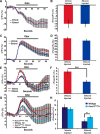Ethanol Regulates Presynaptic Activity and Sedation through Presynaptic Unc13 Proteins in Drosophila
- PMID: 29911175
- PMCID: PMC6001265
- DOI: 10.1523/ENEURO.0125-18.2018
Ethanol Regulates Presynaptic Activity and Sedation through Presynaptic Unc13 Proteins in Drosophila
Abstract
Ethanol has robust effects on presynaptic activity in many neurons, however, it is not yet clear how this drug acts within this compartment to change neural activity, nor the significance of this change on behavior and physiology in vivo. One possible presynaptic effector for ethanol is the Munc13-1 protein. Herein, we show that ethanol binding to the rat Munc13-1 C1 domain, at concentrations consistent with binge exposure, reduces diacylglycerol (DAG) binding. The inhibition of DAG binding is predicted to reduce the activity of Munc13-1 and presynaptic release. In Drosophila, we show that sedating concentrations of ethanol significantly reduce synaptic vesicle release in olfactory sensory neurons (OSNs), while having no significant impact on membrane depolarization and Ca2+ influx into the presynaptic compartment. These data indicate that ethanol targets the active zone in reducing synaptic vesicle exocytosis. Drosophila, haploinsufficent for the Munc13-1 ortholog Dunc13, are more resistant to the effect of ethanol on presynaptic inhibition. Genetically reducing the activity of Dunc13 through mutation or expression of RNAi transgenes also leads to a significant resistance to the sedative effects of ethanol. The neuronal expression of Munc13-1 in heterozygotes for a Dunc13 loss-of-function mutation can largely rescue the ethanol sedation resistance phenotype, indicating a conservation of function between Munc13-1 and Dunc13 in ethanol sedation. Hence, reducing Dunc13 activity leads to naïve physiological and behavioral resistance to sedating concentrations of ethanol. We propose that reducing Dunc13 activity, genetically or pharmacologically by ethanol binding to the C1 domain of Munc13-1/Dunc13, promotes a homeostatic response that leads to ethanol tolerance.
Keywords: Drosophila; Munc13-1; ethanol; presynaptic; resistance; tolerance.
Figures



Similar articles
-
The pre-synaptic Munc13-1 binds alcohol and modulates alcohol self-administration in Drosophila.J Neurochem. 2013 Sep;126(6):715-26. doi: 10.1111/jnc.12315. Epub 2013 Jun 10. J Neurochem. 2013. PMID: 23692447 Free PMC article.
-
MUNC13-1 heterozygosity does not alter voluntary ethanol consumption or sensitivity in mice.Alcohol. 2020 Mar;83:89-97. doi: 10.1016/j.alcohol.2019.06.007. Epub 2019 Jun 29. Alcohol. 2020. PMID: 31265903 Free PMC article.
-
Munc13-1 C1 domain activation lowers the energy barrier for synaptic vesicle fusion.J Neurosci. 2007 Jan 31;27(5):1200-10. doi: 10.1523/JNEUROSCI.4908-06.2007. J Neurosci. 2007. PMID: 17267576 Free PMC article.
-
Unc13 Aligns SNAREs and Superprimes Synaptic Vesicles.Neuron. 2017 Aug 2;95(3):473-475. doi: 10.1016/j.neuron.2017.07.017. Neuron. 2017. PMID: 28772115 Review.
-
Molecular organization and assembly of the presynaptic active zone of neurotransmitter release.Results Probl Cell Differ. 2006;43:49-68. doi: 10.1007/400_012. Results Probl Cell Differ. 2006. PMID: 17068967 Review.
Cited by
-
TBI and Tau Loss of Function Both Affect Naïve Ethanol Sensitivity in Drosophila.Int J Mol Sci. 2024 Mar 14;25(6):3301. doi: 10.3390/ijms25063301. Int J Mol Sci. 2024. PMID: 38542275 Free PMC article.
-
Transcriptional analysis of the response of C. elegans to ethanol exposure.Sci Rep. 2021 May 26;11(1):10993. doi: 10.1038/s41598-021-90282-8. Sci Rep. 2021. PMID: 34040055 Free PMC article.
-
Receptors and Channels Associated with Alcohol Use: Contributions from Drosophila.Neurosci Insights. 2021 Mar 30;16:26331055211007441. doi: 10.1177/26331055211007441. eCollection 2021. Neurosci Insights. 2021. PMID: 33870197 Free PMC article. Review.
-
Differential Expression of Presynaptic Munc13-1 and Munc13-2 in Mouse Hippocampus Following Ethanol Drinking.Neuroscience. 2022 Apr 1;487:166-183. doi: 10.1016/j.neuroscience.2022.02.008. Epub 2022 Feb 12. Neuroscience. 2022. PMID: 35167938 Free PMC article.
-
Identification of alcohol-binding site(s) in proteins using diazirine-based photoaffinity labeling and mass spectrometry.Chem Biol Drug Des. 2019 Jun;93(6):1158-1165. doi: 10.1111/cbdd.13403. Epub 2018 Oct 22. Chem Biol Drug Des. 2019. PMID: 30346111 Free PMC article.
References
-
- Berger KH, Heberlein U, Moore MS (2004) Rapid and chronic: two distinct forms of ethanol tolerance in Drosophila. Alcohol Clin Exp Res 28:1469–1480. - PubMed
Publication types
MeSH terms
Substances
Grants and funding
LinkOut - more resources
Full Text Sources
Other Literature Sources
Molecular Biology Databases
Miscellaneous
